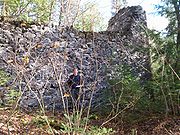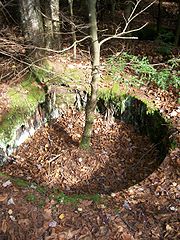
Nonesuch Mine
Encyclopedia


Copper
Copper is a chemical element with the symbol Cu and atomic number 29. It is a ductile metal with very high thermal and electrical conductivity. Pure copper is soft and malleable; an exposed surface has a reddish-orange tarnish...
mine
Mining
Mining is the extraction of valuable minerals or other geological materials from the earth, from an ore body, vein or seam. The term also includes the removal of soil. Materials recovered by mining include base metals, precious metals, iron, uranium, coal, diamonds, limestone, oil shale, rock...
and small ghost town
Ghost town
A ghost town is an abandoned town or city. A town often becomes a ghost town because the economic activity that supported it has failed, or due to natural or human-caused disasters such as floods, government actions, uncontrolled lawlessness, war, or nuclear disasters...
in the southeast corner of the Porcupine Mountains
Porcupine Mountains
The Porcupine Mountains, or Porkies, are a group of small mountains spanning across the northwestern Upper Peninsula of Michigan in Ontonagon and Gogebic counties, near the shore of Lake Superior. The area is part of the Porcupine Mountains Wilderness State Park...
State Park in Carp Lake Township
Carp Lake Township, Ontonagon County, Michigan
Carp Lake Township is a civil township of Ontonagon County in the U.S. state of Michigan. The population was 891 at the 2000 census.-Communities:*White Pine is an unincorporated community in the township...
, Ontonagon County
Ontonagon County, Michigan
-National protected areas:* Keweenaw National Historical Park * Ottawa National Forest -Demographics:As of the census of 2000, there were 7,818 people, 3,456 households, and 2,225 families residing in the county. The population density was 6 people per square mile . There were 5,404 housing units...
, near Silver City, Michigan
Michigan
Michigan is a U.S. state located in the Great Lakes Region of the United States of America. The name Michigan is the French form of the Ojibwa word mishigamaa, meaning "large water" or "large lake"....
, United States
United States
The United States of America is a federal constitutional republic comprising fifty states and a federal district...
. The area was given its name soon after Ed Less discovered the Nonesuch vein of copper on the Little Iron River in 1865. The name refers to the occurrence of the copper in sandstone: "nonesuch" ore existed elsewhere in the Copper Country.
The life of Nonesuch was relatively short. It saw its first mining in 1867 and its last in 1912. The mine was opened and closed five different times, each under different ownership. The only time it made a profit was in the period 1879-1881.
A US post office operated at Nonesuch from 1876 to 1887. Between 1881 and 1884 the town reached its peak with a population of about 300. The town included school with 30 students, as well as a boarding house, livery stable, markets, stage coach service, and a uniformed baseball team.
The copper at the mine was found in a 4 feet (1.2 m) bed of sandstone, and the underlying shale, also a few feet thick. These shales and sandstones were given the name Nonesuch shales and sandstones because they were rocks with very fine copper in them. This unusual (for the Copper Country
Copper Country
The Copper Country is an area in the Upper Peninsula of Michigan in the United States, including all of Keweenaw County, Michigan and most of Houghton, Baraga and Ontonagon counties. The area is so named as copper mining was prevalent there from 1845 until the late 1960s, with one mine ...
) form of copper was ultimately the reason for the mine's repeated failures. It was very difficult to separate the fine copper from the surrounding rock. As was common practice in the Copper Country, the ore was crushed in a stamp mill
Stamp mill
A stamp mill is a type of mill machine that crushes material by pounding rather than grinding, either for further processing or for extraction of metallic ores. Breaking material down is a type of unit operation....
and concentrated by gravity. However, the gravity separators of the time could not efficiently separate the fine copper particles, and much copper was lost in the waste tailings.
By February 1887, the Nonesuch mine was completely stripped of its machinery, which was brought to the dock in Union Bay to be shipped to other mines in the area. A few stayed in town after the mine shut down and logged or farmed to make a living. In 1906 The Calumet and Hecla Mining Company
Calumet and Hecla Mining Company
The Calumet and Hecla Mining Company was a major copper-mining company based in the Michigan Copper Country. In the 19th century, the company paid out more than $72 million in shareholder dividends, more than any other mining company in the United States during that period.-History:In 1864, Edwin J...
brought 200 tons of mining equipment to Nonesuch and explored the area. They eventually opened a mine in the Nonesuch shale at White Pine
White Pine, Michigan
White Pine is an unincorporated census-designated place in Ontonagon County the U.S. state of Michigan. As of the 2010 census, its population was 474....
, three miles due east of Nonesuch. Four years later in 1912, a 20-person crew was sent to Nonesuch to start mining, but shut down in less than a year. The mine never again reopened.
Copper expert Horace Stevens commented in 1902:
- "Discovered in 1865 the mine was first opened in 1867, since which time it has swallowed several large fortunes, and has yielded the insignificant amount of 180 tons 1,072 pounds of refined copper from one of the richest beds of copper-bearing rock ever opened."
- "The copper is there-millions and millions of pounds of it, not worth a penny a ton in the mine. Some day the problem will be solved, and a new crop of millionaires made from the Nonesuch."
Total recorded production of the mine was 390 thousand pounds of copper.
In 1955, the Copper Range Company
Copper Range Company
The Copper Range Company was a major copper-mining company in the Copper Country of Michigan, United States. It began as the Copper Range Company in the late 19th century as a holding company specializing in shares in the copper mines south of Houghton, Michigan...
opened the White Pine mine, solved the problems of mining and treating the ore, and successfully mined copper from the Nonesuch Shale
Nonesuch Shale
The Nonesuch Shale is a Proterozoic geologic formation that outcrops in Michigan and Wisconsin, United States, but has been found by drill holes to extend in the subsurface as far southwest as Iowa....
for the next 40 years.

